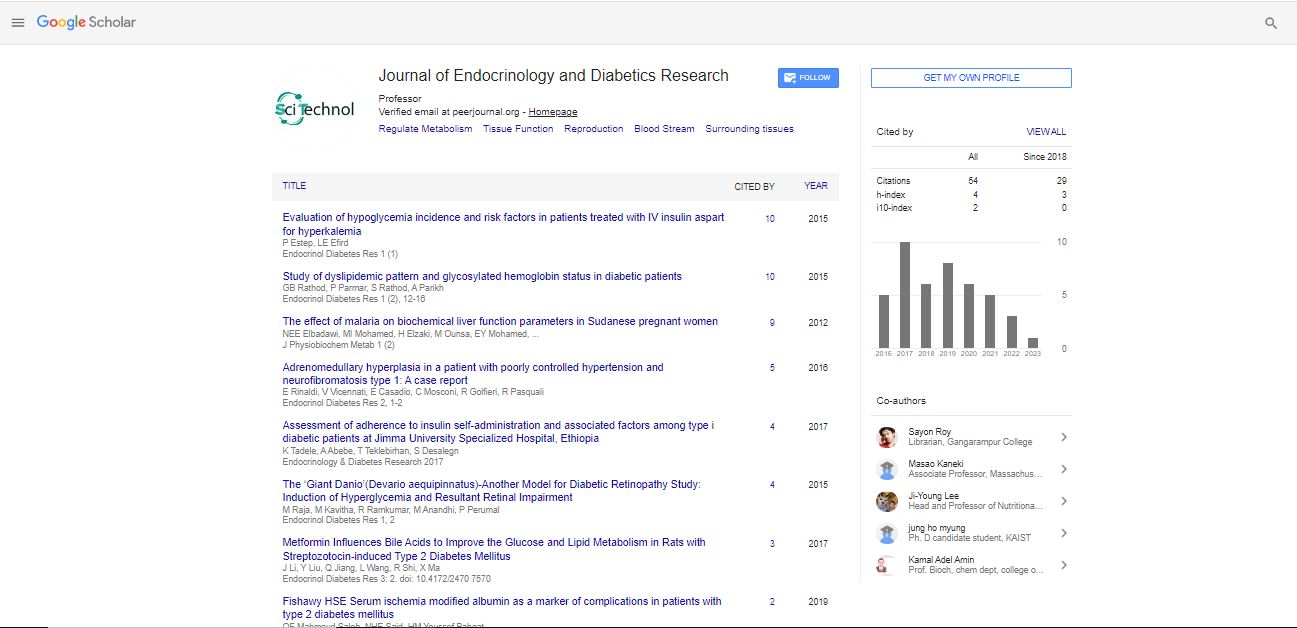The role of continuous glucose monitoring/cgm/ in improving the quality of care of patients with diabetes mellitus/dm/ type -1 and - type 2 in internal medicine residency clinic
Andre Emanuilov Manov
Sunrise Health Consortium GME, USA
: Endocrinol Diabetes Res
Abstract
Diabetes mellitus affects more than 34 million and pre- diabetes mellitus affects 88-million Americans and the prevalence is rising. The disease leads to micro and macrovascular complications if uncontrolled. Diabetes Mellitus is the number one cause of blindness, non-traumatic amputation and ESRD in the USA. In our study, we retrospectively looked at patients in which as a standard of care Continuous Glucose Monitoring (CGM) with Dexcom G6 Device was started in Internal Medicine Residency Continuity Community clinic in Mountain View Hospital, Las Vegas, Nevada in 11-patients with type- I and type- II diabetes mellitus uncontrolled on 3-4 injections of Insulin per day who were self- monitoring their blood glucose 4- times a day (SMBG). The CGM was initiated by internal medicine residents through a remote portal, and the subsequent titration of the insulin dose was done by the residents under the supervision of a board-certified endocrinologist who was also a member of the clinic. The goal of the present study was to demonstrate improvement of patients’ HbA1c measured by a glucose management indicator, a decrement of mild, defined as less than 70 mg/dl hypoglycemia and severe- defined as less than 54 mg/dl hypoglycemia to less than 4% and 1 % respectively, achievement of time in range between 70- 180 mg/dl blood sugar in 24-hour period of 50-70% of the time based on the patient’s age and have glucose variability less than 36%. The HbA1c was reduced in 3- months after introduction of the CGM from 10.5% to 7.47%, the mild hypoglycemia with blood sugar less than 70 mg/ dl happened on average 7- minutes a day (less than 4%) from 27- minutes and severe hypoglycemia happened 3- min a day (less than 1%) from 7 minutes while the patients were using SMBG. These were the goals with the use of CGM. Time in range we achieved was 62% which was between 50 and 70 %. Based on the average age of the patient of 53- years this is compatible with the goals using CGM. The glucose variability was 29% below the goal of 36% which is excellent. The patient satisfaction with the device measured by the CGM Quality of life questionnaire was very good. The unique feature of this study is that it demonstrates the successful introduction of the CGM was done by Internal Medicine Residents under the supervision of a Board-Certified Endocrinologist who was also a member of the clinic which we are not aware that it was done before.
Biography
Andre Emanuilov Manov was a ABIM Board Certified in Internal Medicine, Endocrinology. 50 publications Peer reviewed Journals in Area of Endocrinology and Internal medicine in the USA, England, France and Bulgaria. Worked as Assistant, Associate and Full Professor to the students from University of North Texas Health Science Center/UNTHSC/ from 2011-2018 in John Peter Smith Hospital, Fort Worth, TX. I was a Course director in Endocrinology at a level of Professor for 2-nd year medical Students in UNTHSC-2017-2018. Professor in TCU and UNTHSC School of medicine since 2016. He was Associate Program Director of Internal medicine in Sunrise health GME Consortium 05/ 01/2020-05/01/2021, Mountain View Hospital, Las Vegas Nevada, USA and now he was core Faculty in Internal medicine in the same Program. From 05/01/2021- he become Transitional Year Residency Program Director in the same Hospital and GME program. I am Professor of Medicine in Touro and Reno Universities of Nevada since 08/2020. I am Director of Internal Medicine Residency clinic and teaching Internal medicine residents from the Sunrise health GME consortium as a core Faculty and Transitional Year Residents from the same consortium in Internal medicine and Endocrinology. He Discovered for first time the adhesion molecule CD44 on snap frozen sections and thyroid cells overexpression in Grave’s disease and Thyroid nodules in 1991.
 Spanish
Spanish  Chinese
Chinese  Russian
Russian  German
German  French
French  Japanese
Japanese  Portuguese
Portuguese  Hindi
Hindi 


